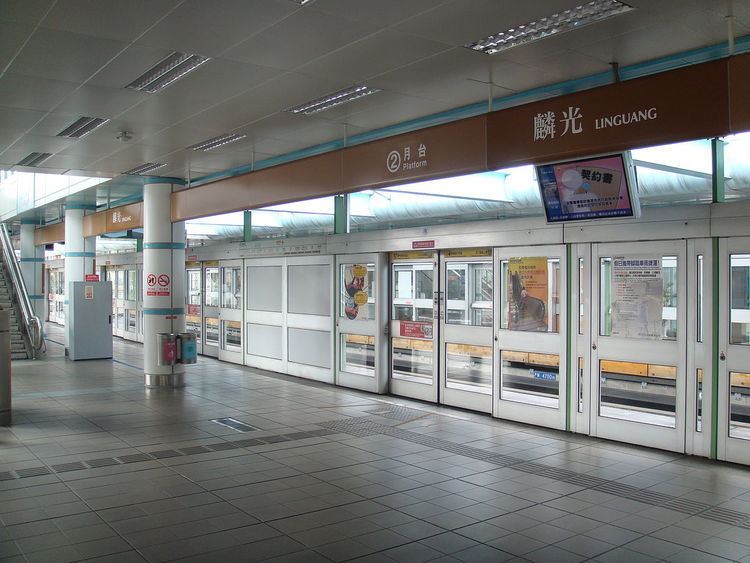Type People mover system Status Operational Stations 12 | System Taipei Metro Locale Taipei, Taiwan | |
 | ||
Termini Zhongshan Junior High School
Taipei Zoo | ||
The Taipei Metro Wenshan Line (previously known as the Muzha Line before October 8, 2009) is an elevated, medium-capacity line in Taipei, Taiwan. It was the first line on the Taipei Metro, consisting of 12 stations over 10.9 km. Opened on March 28, 1996, after construction delays compounded with legal tussles, the fully elevated people mover system is driverless and fully automated. A full-length journey on the line takes 22 minutes, and it is labelled as part of the Brown Line on the Taipei Metro. Currently, services are operated using 4-car Bombardier Innovia APM 256 rolling stock as well as the retrofitted VAL 256 trains and directly connect to the Neihu Line.
Contents
History
Construction of the Wenshan Line began in December 1988 at a cost of NT$42.6 billion. It was plagued by controversy, cost overruns and technical problems from its development up to a few years after its opening. Originally slated to commence passenger service in December 1991, its revenue operation was repeatedly delayed up to 28 March 1996 owing to numerous accidents. Public confidence was shakened as incidents of lightning strikes, computer failures, two instances of rolling stock derailment and catching fire each were reported during the testing phase. In 1999, cracks were found on the elevated pillars forcing the line to shut down temporarily.
One of the largest suppliers for the system, Matra, which supplied the VAL 256 rolling stock and electrical systems for the line sued the Department of Rapid Transit Systems of the Taipei City Government for costs overruns claiming to have resulted from the latter failing to provide the necessary infrastructure to build the line. Subsequently, the company pulled out of the operation of the line in 1994. Chen Shui Bian, then Mayor of Taipei declared that progress and operation of the line would continue despite the walkout in the now-popular catchphrase "馬特拉不拉,我們自己拉" (lit: If Matra doesn't pull, we'd pull it ourselves). After a 12-year-long legal tussle, in 2005, Matra was awarded NT$1.6 billion (approx. US$50 million) in damages by the Supreme Court of the Republic of China.
Services on the Wenshan Line began with two-car operation of the VAL 256 coupled together. Eventually, increasing patronage on the system led to operation in four-car configurations. The opening of Maokong Gondola in 2007 have also boosted passenger numbers travelling on the line to Taipei Zoo for transfer.
The Wenshan Line is connected to the Neihu Line, which opened in July 2009. It connects to Neihu and Taipei Songshan Airport, which currently has no rapid transit access. Since an alternative contractor Bombardier was awarded to supply the rolling stock and the signaling system for the new line, the Wenshan Line's signaling system was converted to suit the new communication-based train control (CBTC) CITYFLO 650 to allow both the old Matra rolling stock and the new Bombardier rolling stock to run in co-existence. On December 19, 2010, fifty-one pairs of retrofitted VAL256's (from the Matra rolling stock) will begin testing on the entire line. After over half a year of testing, the additional trains will decrease the time between trains at rush hour from 2 minutes to 72 seconds and bring the total number of trains operating on the line to 152 pairs.
Rolling stock
The line was operated by the 2-car driverless VAL 256 built in 1993. A total of 102 cars were built with a maximum capacity of 114 passengers each. The fleet ran on rubber-tyred track at a maximum speed of 80 km/h.
With the opening of the Neihu Line, the entire line switched over to the new automatic train control CITYFLO 650 using Innovia APM 256 trains (produced by Bombardier). As of December 19, 2010, trials are being run on retrofitted VAL 256 trains modified to run on both the Muzha and Neihu Lines. The trains are expected to fully enter revenue service after testing by December 26, 2010. On December 26, 2010, the line will operate with 6 pairs of the retrofitted VAL 256's and 25-29 pairs of the Innovia 256's. By December 27, the ratio is expected to increase, with 10 pairs of VAL 256's and 40 pairs of the Innovia 256's.
Stations
All stations are fully equipped with platform screen doors and disabled-accessible facilities.
